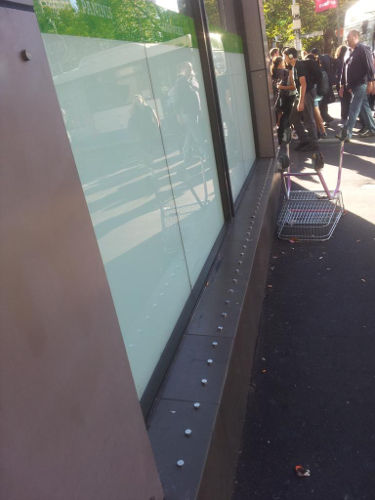Subtle Design Changes To Australia’s Inner Cities Are Making Life Harder For The Homeless
From public toilets to park benches, homeless people are being cut off from the spaces around them.

Last week, the WA Department of Culture and the Arts found itself under fire after it installed a sprinkler system on Perth’s King Street Arts Centre building. The high-pressure sprinklers, which came on for thirty seconds every hour at night, were designed to keep homeless people from sleeping in an alleyway next to the building.
People were horrified by what they felt was a cruel and humiliating anti-homeless measure, with St Vincent de Paul Society CEO Mark Fitzpatrick declaring: “You wouldn’t treat a dog like that”. A petition started by Common Grace’s Jarrod McKenna demanding that the sprinklers be removed swiftly gathered over 15,000 signatures, and television news coverage saw the pressure build even further. Yesterday, the Department announced that the sprinklers have been uninstalled.
The controversy was arguably the most prominent homegrown example of a phenomenon springing up in cities all over the world; architecture and public planning designed to stop homeless people from sleeping, begging or congregating in areas where they might be deemed a nuisance. Known as “hostile architecture,” it’s triggered a backlash in cities like London and Montreal, where spikes and studs have been installed in building alcoves and under overpasses to deter homeless people from setting up.
Anti homeless floor studs. So much for community spirit :( pic.twitter.com/Yz8VF7Ryid
— Ethical Pioneer (@ethicalpioneer) June 6, 2014
Designing public spaces in ways that discourage certain behaviours is commonplace but easily missable if you don’t know what to look for; innocuous studs and knobs on banisters, public steps and railings are usually there to drive away skateboarders, and Hamburg made headlines earlier this year for using a special water-repellent paint to stop people drunkenly pissing on public buildings. There’s even a device called the Mosquito that emits a high-frequency sound supposedly audible only to people under 25, which Sydney’s State Rail considered using as a way to counter graffiti and vandalism in 2013.
But hostile architecture is specifically designed with the homeless in mind, and explains a lot of features in public spaces you might never have thought of. Set metal armrests that divide public benches and bus stops into individual seat-spaces aren’t just to help people relax while they’re sitting down; they’re also there to stop homeless people using them as makeshift beds.
While less common here than overseas, anti-homeless studs have begun popping up in Australian cities too; this ledge on Sydney’s Foveaux Street, which homeless people selling copies of The Big Issue used to rest on, gained its own set of studs once a newly-minted Woolworths occupied the building. My butt can confirm they’re uncomfortable even after sitting for a short time, let alone trying to sleep, and my butt does not lie about these things.

More recently, train stations in several cities have begun vigorously policing access to their toilets. In the last few months, ticket barriers at three of the largest metropolitan train stations in Sydney– Wynyard, Town Hall and Central — have been moved outward so that station toilets fall inside the pay-for-access zone, rendering them off-limits for anyone who doesn’t have a ticket or paid-up Opal Card. Belmore Park, across the road from Central Station, has become host to a semi-permanent “tent city” of around 40 homeless people in recent months. In Melbourne, meanwhile, major new stations like the one completed at Southlands last year are being built without toilet facilities at all.
Complicating matters is the fact that state and federal funding cuts are forcing shelters and programs working with the homeless — especially those dedicated to female victims of domestic violence — to reassess the sort of services they can provide, with many contemplating outright closure. As homelessness rates spike, people turned away from already-stretched emergency housing and hostels are more likely to run afoul of hostile architecture or its consequences, especially when it works in tandem with existing policies that already make it difficult for homeless people to live.
Public urination in NSW, for instance, falls under a broad “anti-social behaviour” category, and carries a fine of up to $500. But in a city where train station toilets are increasingly inaccessible for non-paying customers, where homeless people are meant to go to the toilet is a question with no ready answers.
Overseas, there are pushbacks against hostile architecture and the mindset behind it; Vancouver’s bus stops famously fold out into homeless shelters at night, and groups in Melbourne, South Africa and Los Angeles are providing creative solutions to give homeless people quick accommodation and services like clothing and haircuts. But in Australia, hostile architecture dovetails distressingly well with existing policies that target the homeless; begging is illegal in Melbourne, where it can be met with a $100 fine and a court appearance, and WA has long been considering proposals to outlaw begging in the Perth CBD that could see police seize homeless people’s money as the proceeds of crime.
But as we saw this week, that kind of hostility towards homeless people can paradoxically focus people’s attention on homelessness and demand better from their governments. In the wake of the outcry over the Perth sprinklers, the WA government has announced it is increasing its target of affordable homes by 10,000 — an expansion of a program that has already seen 20,000 affordable homes delivered to vulnerable people in the state. In a country where homeless people are suffocating in their cars from using the heater to keep warm at night, we can probably find more sophisticated responses to poverty and homelessness than putting uncomfortable armrests on park benches.
–
Feature image via Colleen Galvin on a Flickr Creative Commons license.